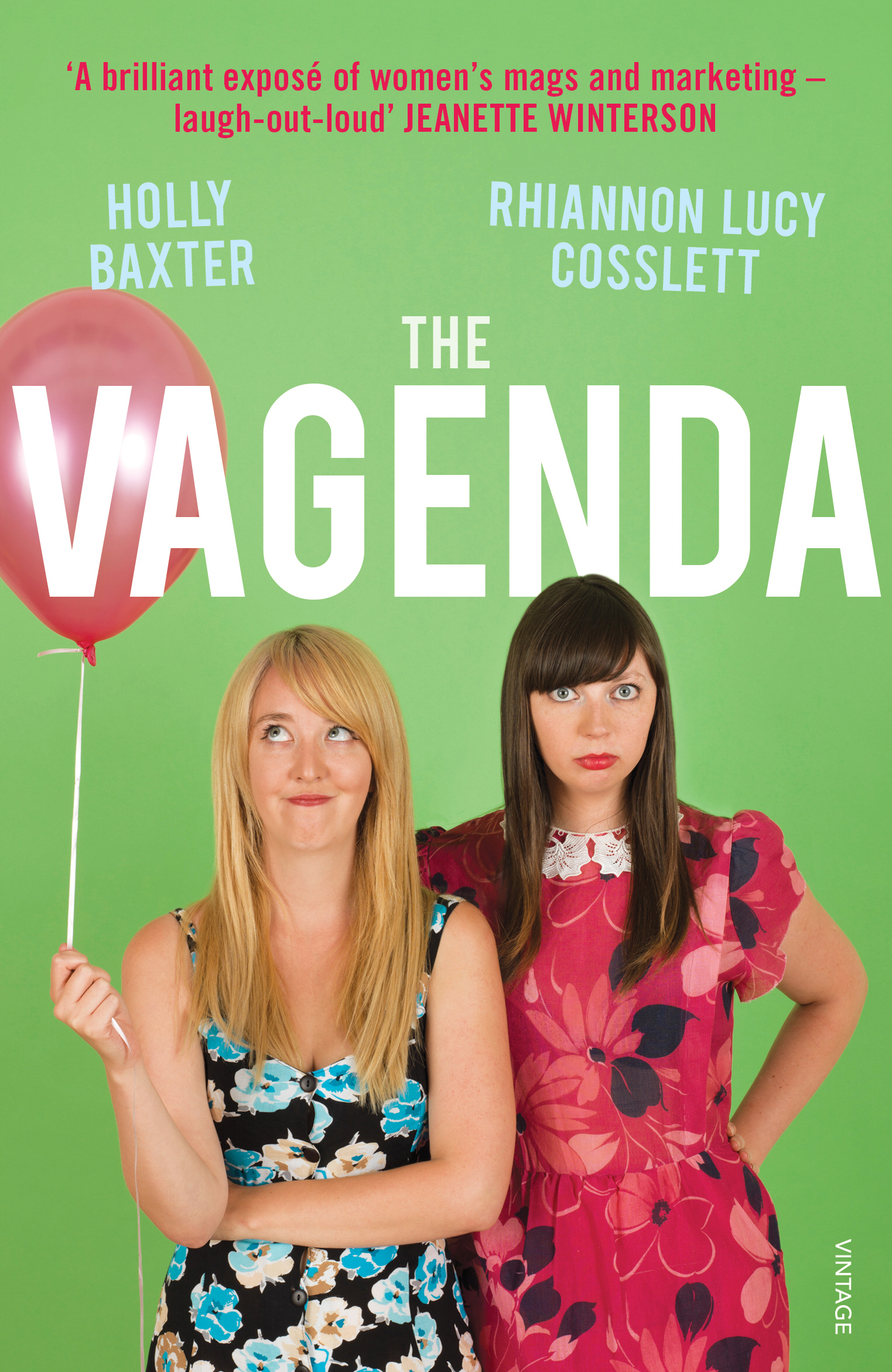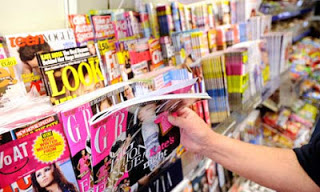I took Cosmo for a spin before I’d kissed a boy or earned a pound of my own money, and it was probably too heavy for my skinny arms to support, let alone for my brain – drowsy with hormones – to bullshit-detect. When I grew up, I wanted to be just like the women crowding their pages: tall and tanned and shiny-haired and wearing ‘just a little something I got from a vintage market’ and working in an office and having an office romance and writing to an agony aunt about the office romance because he hadn’t called but it’s OK, because Cosmo girls are fun fearless females (just make sure he wears a condom!) Cosmo girls have fun, but fun will cost you a month’s rent for a tub of Crème de la Mer night cream and endorses waxing your pubes before the age of consent so they might ‘eventually stop growing altogether’, as if Barbie dolls had had the right idea all along, but whatever. Aged 13, I thought this was entirely reasonable; nothing else I’d read had disputed this and, after all, who was I to question the mavericks who recommended that I wear a face mask made of mashed up avocado and maple syrup? No-one had given me advice this detailed before – to reject it would be churlish – and, probably, girlish. Cosmo was the first step on my path to womanhood, but I was in the morning of my adolescence and it was going to cost me a a painful £3.20 a month just to subscribe. It was a tough spend. Did I mention how expensive avocados are?
See, that was the thread of consistency that went through every magazine I fawned over throughout my magazine affairs: they were all itching for you to part with your cash. Even the teenage ones, about which I practiced a chaste kind of promiscuity that CosmoGIRL would warn me from and Cosmo Sr. would inspire. I jumped from Mizz (too glittery) to Sugar to J17 to CosmoGIRL to Bliss (too saccharine a name) to ElleGIRL. I stuck it out with ElleGIRL because I’d suddenly discovered the term ‘individual’ and appreciated their commitment to stitching sequins onto garments from a clothing range their demographic could not afford unless their copy of the magazine had been bought from a Londis on The King’s Road (if, indeed, the borough of Kensington and Chelsea allows common things like corner shops to reside along its gold-plated pathways.)
The end to my love affair with women’s magazines came in my second year of university, when – having thrown hundreds of pounds down the drain to be repeatedly lectured about the same fashion trends, health concerns and relationship advice for years – I realised with some trepidation and some elation that though I might be a CosmoGIRL, I was never going to be a Cosmo woman. I’d always assumed that the magazine elders were right about my fate – eventually the blouses and pencil skirts they featured would fit my frame, and I’d be able to afford the non-high street versions if I wanted. I’d get a job and let my outfit do the talking for that all-important promotion, and I could finally find relevant the parts of the magazine that had eluded me.
But then I realised, embarrassingly late, that this was not the way the world worked, and the kind of aspirational lifestyle the magazines pedalled was only depressing me, rather than motivating me. Real life stories (the juicy, funny ‘I got pregnant even though all I did was take the bins out’ ones had been relegated to a different kind of magazine altogether by then) became fixated on preened and privileged women who were the exception, rather than the rule. I tired of reading about women who had become CEOs of companies weeks after giving birth to twins, or who had written an award-winning novel in a Parisian apartment aged 24 with no mention of how she funded herself. These were women placed to make me feel envious and participate in the sport of envy – buying. I hadn’t a hope of becoming one of these accomplished anomalies – not yet, at least – but if I spent enough time with a St. Tropez self-tan mitt, I might have a hope of looking like some of the women on page 67.
Despite the fact that I dumped the rags after this revelation, a certain part of me retains affection for their content. For starters, I’ve an exhaustive education on yeast infections to rival even the most conscientious gynaecologist (as though they think women can only come down with one illness and must remind their readers of the fact every issue. Or, y’know, they run out of ideas for the made-up problem pages.) But it was the self-contradiction that was the final nail in the coffin. Features slut-shaming drunk students co-exist amongst articles detailing how to make the streets safer for women at night. We are inundated with weight loss advice less than ten pages from the last sensationalised eating disorder story. As a young teen with an appetite for reading – ignorant of Greer and Friedan and de Beauvoir – I knew no alternative to the ‘women’s lifestyle’ section of the newsagents. I was an ideal member of their target audience.
I’ve since constructed an ideal for living that takes no inspiration from the shallow materialism that magazines advocate, but finding a replacement for Cosmo is an ongoing task. Asda categorises Private Eye as a men’s weekly – unsurprising as women are famously neither funny nor up to date with current affairs – and I have to root around amongst lad’s mags to get to the NME or Q. Nowadays, reading magazines intended for my own sex has become an exercise in gender politics, rather than the passive hobby I used to enjoy.
And I’ll admit to missing that sometimes.
- SR



One of the bonuses of moving to Vancouver was discovering Bust.
It’s a woman’s magazine with great music and book reviews, articles and interviews about female scientists, actresses, musicians and writers. I’ve discovered really good bands through it. Plus it has amazing diy projects…my terrarium, mobile and kombucha tea are all courtesy of Bust. They also cover some current affairs.
And there are no dieting articles – the fashion spreads are very cool and seem to feature models with a little more body diversity than usual. They also sometimes have plus size fashion and fashion bloggers.
They generally feature a great diversity of women in terms of race, occupation and size.
I’ve gotten a subscription and have never regretted it – this magazine is so refreshing!
http://www.bust.com/
PS I used to buy Vogue – but after it had a fawning article with Asma al Assad – I will never buy it again.
http://jezebel.com/5930055/vogue-writer-tries-fails-to-successfully-justify-fawning-asma-al+assad-profile
Just had a look at the Bust website, that magazine sounds ace!
I haven’t bought a women’s magazine in about the last five years either, as I too got to the point where I realised that they were depressing drivel, obsessed with your weight, your hair and aspiring to celebrity. And for some reason, the women they feature were never scientists, or academics, or engineers, or even musicians- but always actresses or uber-successful career mothers running a handbag empire etc – as if science or academia or music were a man-zone to which women couldn’t hope to venture, or maybe shouldn’t venture to because then they wouldn’t be able to afford Prada handbags.
We need Bust in the UK!
I feel like this article could have been penned by my own hand. I was the most dedicated reader of Glamour from its conception (when I was about 14 I think) until about two years ago, likewise embarrassingly late for a person who has proudly considered herself a feminist since primary school. I always thought I could be that woman who is slim, image-concious and expensively dressed, and still a feminist, but more to the point, I thought that magazines like Glamour would eventually lead me to that goal. I’m sorry to say that I didn’t even fully work out for myself that this is a total falsehood; it took reading The Beauty Myth to have it spelt out for me:
“Why do women care so much about what the magazines say and show? They care because, though the magazines are trivialized, they represent something very important: women’s mass culture… The relationship between the woman reader and her magazine is so different from that between a man and his magazine…: A man reading Popular Mechanics or Newsweek is just browsing through just one perspective among countless others of general male-orientate behaviour… A woman reading Glamour is holding woman-orientated culture between her two hands… they are all most women have as a window on their own mass sensibility.”
Naomi Wolf goes on to state that though the editorial can be quite feminist, the whole concept of SELLING to women who are never quite good enough canNOT be, and these together make up a mixed message that makes breaking free quite difficult. She also describes how the tone taken in similar to that of a kindly elder female relative, looking out for you and trying to ‘fix’ you simultaneously.
I always stop by the magazine racks in shops and stare at the covers with longing. I don’t feel stupid for wanting them so much now I understand why I do. I contribute the money I would have spent on magazines in my monthly donations to Amnesty and the time and money I would have spent trying to live up to their idealized, unobtainable lifestyle on having a great life and investing in my career! And in place of Glamour, I read The Vagenda
P.S. I’ve subscribed to Private Eye for years and though I love it and read every issue… and ADORE Ian Hislop to the extent he wins my ‘Who would you spend a night with on a free pass’ game every time, it really isn’t the same…
I was blown away when I went to a bookshop in Austria and saw all the smart, trendy magazines aimed at women. I think the German-speaking worlds puts Brits to shame!
Likewise @Painted Alice, I was a Glamour fanatic throughout my teen years. I read the Beauty Myth about 18 months ago and since then have not managed to get past the first few pages of a “woman’s” magazine, even when just glancing at a housemate’s or in the doctor surgery.
I guess it’s when you realise that you actually feel unhappier about yourself and your life after reading them…
Wow that was odd. I just wrote an extremely long comment but after I clicked submit my comment didn’t show up. Grrrr… well I’m not writing all that over again. Anyways, just wanted to say superb blog!